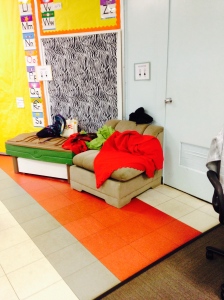Somatosensory activities and education, this is a topic close to my heart.
For a little over two years now I have been consultant and then project manager of a pilot project in Australia looking at the inclusion of patterned, repetitive somatosensory activities in primary school classes.
So often we hear teachers and educators ask about strategies for managing traumatised children and their resultant behaviours in the classroom. All too often in my clinical practice teachers have looked at me, perplexed when I suggested they could include somatosensory activities into curriculum. In fact I had almost got to the point that I believed this maybe wasn’t achievable and that I had to enlist an education champion to help me articulate my meaning more clearly. The latter may still be the case, but in Charlotte NC I had the professionally heart warming experience of watching a relatively new teacher to the Alexander Youth Network (AYN) Psychiatric Residential Treatment Facility (PRTF) School do exactly what I’ve been talking about for years.
The PRTF School do what most neurodevelopmentally and “trauma” informed education programs do, by providing frequent “brain breaks” for their children. Essentially this is where they step down from academic learning and engage in some form of somatosensory activity such as playing outside, water play, sand play, play doh, calming corners with sofas, bean bags, blankets and soft toys etc. They do this routinely, repetitively and frequently – in fact given the arousal and dysregulation of the children AYN sees in its PRTF, these breaks seemed to work best when applied every 10 or so minutes. Having access to a staff member dedicated to leading these breaks and co-regulating the children in between them worked a treat as well. All of this impressed me, but what really stood out was this one teacher who found a way to incorporate somatosensory activities into curriculum based learning!
You know maths and mathematical concepts is a difficult gig at any school, let alone a classroom of children struggling with emotional, social and behavioural difficulties. So when this teacher came in to teach the concepts of less than and greater than I thought to myself this will be interesting.
Immediately on entry into the room, she invited the children to the front of the class and had them all stand or sit around her as they preferred. She didn’t get flustered or annoyed when children came and went from her teaching space and in doing so, actually appeared to manage keeping them around her and in the vicinity of learning for the whole exercise. Each child was given a piece of paper containing a number, each child read their number out aloud. The greater than symbol was drawn on the board and there was minimal question and answer time to ensure that everyone understood the concept of the greater than symbol.
Then engaging the students in an activity based process, moving them around she asked them two by two (based on those most engaged in the moment) to identify their number and stand either side of her – as she held the greater than symbol. The student’s task – to put themselves in the right spot – who’s number was greater than the other. Each student excitedly took their turn and much celebration was had as each pair got it right. In addition to the movement which we know provides sensory and motor based regulation to the lower parts of the brain, this teacher relied on her voice to ensure up regulation and down regulation in the moment and what was most impressive was that she made the lesson punchy and brief. In and out in no more than 15 minutes and a key mathematical concept was taught and grasped by these children.
Can somatosensory activity be incorporated into curriculum?
I think it can. It might take a bit of creativity and planning, and maybe even a shift in basic education philosophy about how to teach children, but I still think this is very achievable.


One comment